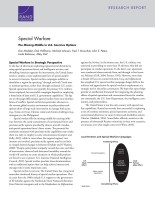| 来源类型 | Research Reports
|
| 规范类型 | 报告
|
| 来源ID | RR-828-A
|
| Special Warfare: The Missing Middle in U.S. Coercive Options |
| Dan Madden; Dick Hoffmann; Michael Johnson; Fred Krawchuk; John E. Peters; Linda Robinson; Abby Doll
|
| 发表日期 | 2014
|
| 出版年 | 2014
|
| 页码 | 8
|
| 语种 | 英语
|
| 结论 |
Special Warfare Comes with Advantages...- Special warfare can improve U.S. contextual understanding of potential partners and the situation on the ground.
- Special warfare's small-footprint approach allows the United States to pursue cost-effective, cost-imposing strategies.
- Given a decision to intervene, policymakers could use special warfare to avoid making commitments beyond U.S. interests.
- Special warfare's small-footprint approach can be more fiscally and politically sustainable than alternatives when underlying sources of conflict cannot be resolved in the short term.
...As Well as Risks- A U.S. partner may have core objectives that conflict with those of the United States.
- The opponent's level of capability and operational tempo relative to the partner's may render special warfare solutions ineffective within the required time horizon.
- Some partners may behave in ways that transgress America's normative standards and undermine their own sources of legitimacy.
- If special warfare campaigns are not carefully integrated into a holistic U.S. policy toward the targeted country, U.S. efforts can either turn into direct conflict or become out of balance.
- The global proliferation of information technology erodes the ability to keep covert activities covert, which can place the secrecy of operations at risk.
Authors Identified Eight Campaign Types That Might Help Address Current Strategic Challenges- Hybrid guerrilla warfare in the defense.
- Support to conventional power projection.
- Support to distant blockade.
- Covert foreign internal defense for eliminating weapons of mass destruction.
- Counterproliferation against a global network.
- Foreign internal defense in a fractured state.
- Building a regional security exporter.
- Countergenocide unconventional warfare.
|
| 摘要 |
- When the United States seeks to achieve its goals through special warfare, it will require a different conceptual model to design and conduct campaigns than what it is accustomed to. Special warfare is not, in military parlance, purely a shaping effort, which implies either an effort to prevent or set the conditions for success in conflict. Nor is it purely a supporting effort to conventional campaigns. It is a way of achieving strategic goals, and given recent trends in security threats to the United States and its interests, it may often be the most appropriate way of doing so. As a result, the U.S. national security community needs to begin thinking seriously about special warfare capabilities, authorities, and options in strategic and operational planning. RAND authors recommend that DoD strengthen its special warfare planning capacity and culture, conduct institutional reforms to facilitate unified action among relevant U.S. government agencies, and place greater emphasis on developing capabilities required to prevail in the human domain.
|
| 主题 | Low-Intensity Conflict
; Military Strategy
; Peacekeeping and Stability Operations
; Special Operations Forces
; Warfare and Military Operations
|
| URL | https://www.rand.org/pubs/research_reports/RR828.html
|
| 来源智库 | RAND Corporation (United States)
|
| 资源类型 | 智库出版物
|
| 条目标识符 | http://119.78.100.153/handle/2XGU8XDN/107779
|
推荐引用方式
GB/T 7714 |
Dan Madden,Dick Hoffmann,Michael Johnson,et al. Special Warfare: The Missing Middle in U.S. Coercive Options. 2014.
|
|
文件名:
|
x1495316337979.jpg
|
|
格式:
|
JPEG
|

|
文件名:
|
RAND_RR828.pdf
|
|
格式:
|
Adobe PDF
|
除非特别说明,本系统中所有内容都受版权保护,并保留所有权利。